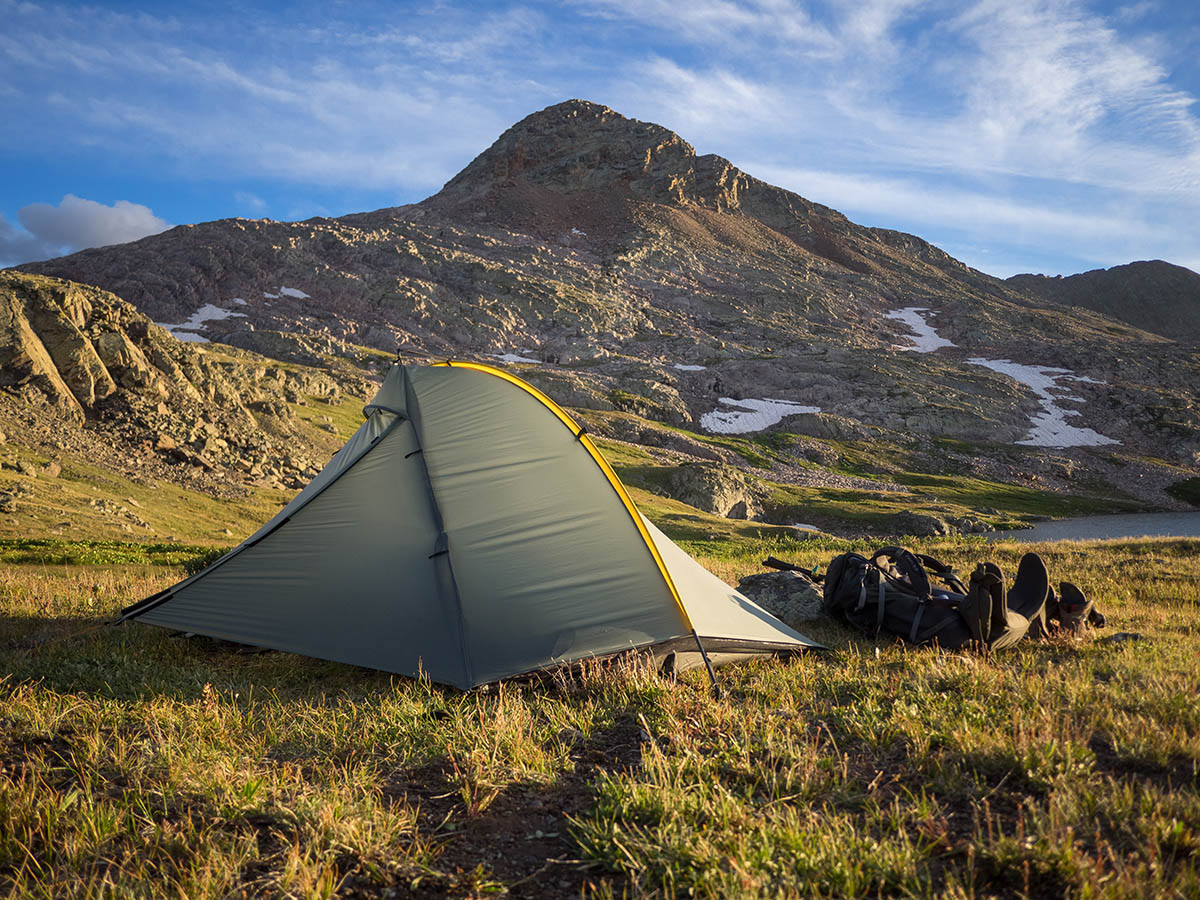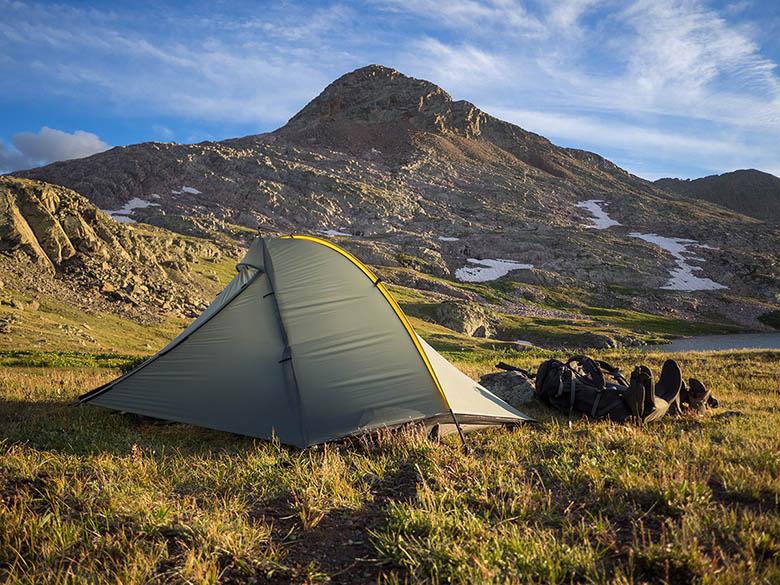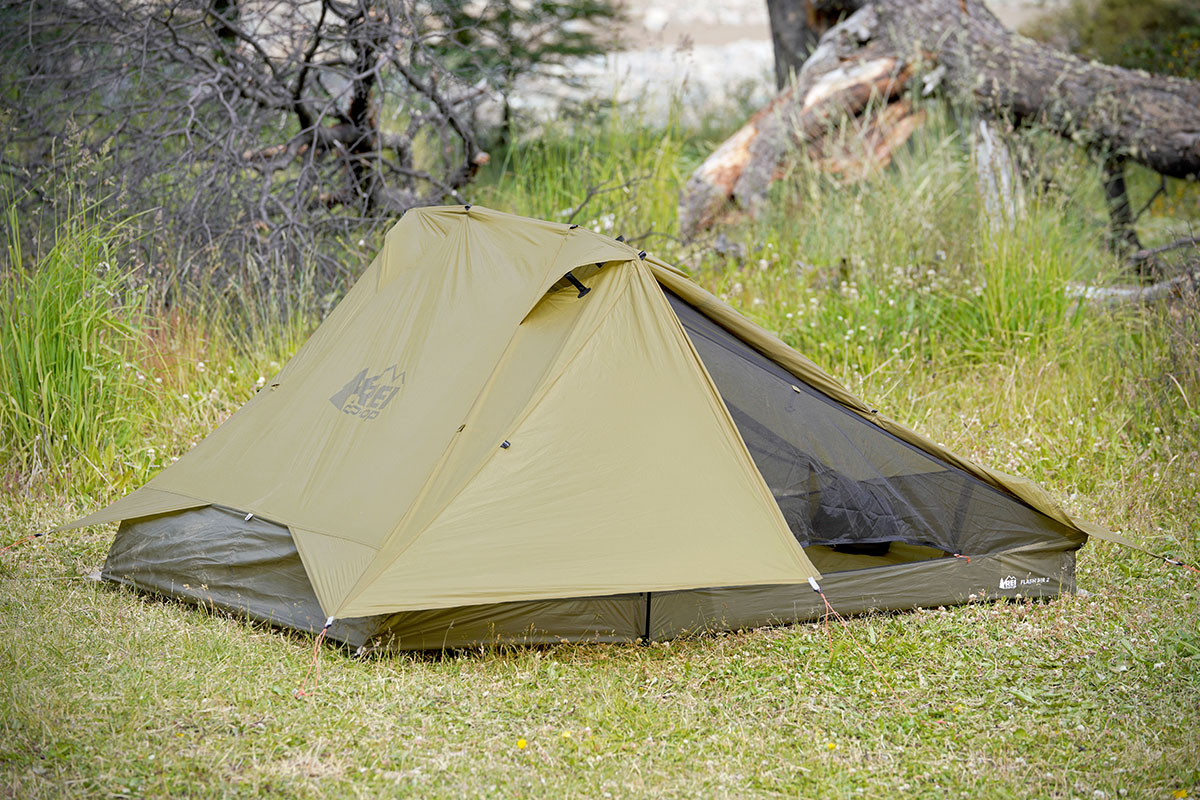

Brett Davis


Brett Davis
Price: $349
Packaged weight: 2 lbs. 9.8 oz.
Floor dimensions: 88 x 50 in.
Floor denier: 30D
What we like: Reasonably priced for a light, roomy, and weather-worthy design.
What we don’t: Hybrid single-wall build is prone to moisture buildup; doesn’t come seam-sealed.
See the Tarptent Double Rainbow
The backpacking tent cottage industry is alive and well, and California-based Tarptent is one of the top brands among dedicated ULers. Their leading two-person model is the Double Rainbow, which hits a competitive balance of usability, weight, and weather protection. We put it to the test through a full season of bikepacking and backcountry exploring in Colorado’s San Juan Mountains and found it to be an impressive ultralight option. Below we outline our experiences with the Double Rainbow. To see how it stacks up to the competition, see our articles on the best backpacking tents and best ultralight tents.
Editor’s note: We tested the past-generation version of the Double Rainbow, and Tarptent has since updated the tent slightly with retooled trekking pole handle adapters, cross strut connectors, and guy-out points. However, the rest of the design remains largely the same.
Weighing 2 pounds 9.8 ounces all in (including the tent body, poles, stuff sack, and stakes), the Tarptent Double Rainbow is extremely light for its size and features. This is largely due to the hybrid single-wall build, which merges a mesh body with a rainfly in one single piece. For comparison, it undercuts popular lightweight, double-wall options like the MSR Hubba Hubba NX and Nemo Dagger (both 3 lbs. 14 oz.), as well as Big Agnes’ Copper Spur HV UL2 (3 lbs. 2 oz.). The few tents that weigh less than the Double Rainbow—like the Nemo Hornet, REI Flash Air, and Big Agnes Tiger Wall and Fly Creek—are made with significantly less durable fabrics. That said, it’s worth noting that the Double Rainbow does not come seam-sealed (you can have Tarptent do the service for $35 or purchase a kit to do it yourself for $8), so total weight will go up a little as a result..jpg)
In terms of packed size, the Double Rainbow is a standout. The thin materials, hybrid single-wall build, and simplistic pole design keep things extremely compact. Tents with hubbed poles or a freestanding design like the Big Agnes Copper Spur take up noticeably more space in your pack. To make it even easier to compress, you can remove the upper strut and store it separately. But we found that keeping it in its sleeve did little to compromise packability. As a prototype, Tarptent sent us a pole bag which also fits the stakes. This bag has sewn-in gear loops, which added protection to the pole when stowed outside of the shelter stuff sack. It also proved to be versatile stowing the pole during bikepacking trips.
For being a minimalist two-person tent, the Double Rainbow is reasonably spacious. Its symmetrical floor and two-door layout comfortably shelter two people and their gear, and the tent easily accommodates a 6-foot stature in length (it’s 88 in. long). The 40-inch peak height is more than ample, and the upper strut that runs widthwise across the middle expands the headroom to the sides and allows two campers to sit up easily without crouching. Our only notable complaint is that we wish the tent were slightly wider (it measures 50 in.). Even sleeping head-to-toe, our sleeping bags pushed against the outer walls and picked up condensation (more on this in “Ventilation” below).
All things considered, we’ve found the Double Rainbow to be relatively durable for an ultralight model. With 30-denier (D) silnylon along the floor and fly, it is made of beefier fabrics than most other backpacking tents in its weight grouping (most of which are in the 15-20D range). But like all shelters in this class, the Double Rainbow is not meant to be abused through rough handling. In particular, care should be taken when inserting and removing the center arch pole into its sleeve—especially when sliding the pole towards the strut, where the pole could catch and tear a hole in the fabric. But to be fair, the zippers on both the vestibule and interior mesh are holding up well, and all of the stitching remains intact after weeks of continuous use. Overall, the Double Rainbow undeniably is an ultralight tent and a good value to boot, but Tarptent didn’t skimp on the level of craftsmanship.
.jpg)
Wind
Despite its minimalist and mesh-heavy build, the Double Rainbow has proven to be a stalwart in the wind. First off, we were impressed with its stability in strong gusts despite having a single-pole structure (the main pole runs lengthwise down the middle of the tent). Its dome-like shape helped it hunker down nicely and avoid the wind-catching personality of similar designs. Additionally, you can raise the ground tarp into the bathtub floor that clips under the fly, creating a barrier against the wind. If you’re meticulous enough in your setup, you can tension the fly so that it sits just above the ground, mitigating the possibility for wind to sweep underneath.
.jpg) That said, with the right gust, dust can blow up and over this rim, filling the tent. Another issue to note: the plastic guyline tensioners on the Double Rainbow are prone to slipping. When this happens, the tension of the tent loosens and its weather protection is compromised. As a quick but not necessarily ideal fix, extend the guylines all the way until the knot hits the tightener and then stake them out tight. The cylindrical stakes provided by Tarptent are not our favorite, and in certain types of ground can be easily unearthed. We recommend purchasing Y-stakes from a company like MSR to anchor your Double Rainbow.
That said, with the right gust, dust can blow up and over this rim, filling the tent. Another issue to note: the plastic guyline tensioners on the Double Rainbow are prone to slipping. When this happens, the tension of the tent loosens and its weather protection is compromised. As a quick but not necessarily ideal fix, extend the guylines all the way until the knot hits the tightener and then stake them out tight. The cylindrical stakes provided by Tarptent are not our favorite, and in certain types of ground can be easily unearthed. We recommend purchasing Y-stakes from a company like MSR to anchor your Double Rainbow.
Rain
While the Double Rainbow doesn’t offer the same level of protection as a heavier double-wall tent, it is designed with inclement weather in mind. We’ve found the 30D, silicone-coated fabric (silnylon) is an effective barrier from precipitation, and more durable than tents of similar weight. For added protection, the corners of the integrated ground cloth can be clipped to attachment points inside the walls. This creates a 3- to 4-inch bathtub floor that guards against running water and provides a barrier against rain beading down the fly and into the tent. But be careful—you must make sure that the fly is guyed out so that it is lower than the top of the bathtub rim, otherwise risk a pool of water in your tent. And a final note on rain protection: as mentioned above, the Double Rainbow does not come seam-sealed. But Tarptent offers an $8 kit to do it yourself or you can have them perform the service for $35.
As is the case with virtually all single-wall shelters, the Double Rainbow is prone to condensation accumulation. That said, Tarptent has designed the shelter with a few especially helpful features that, when put to use, keep most overnight moisture buildup at bay. To start, the bathtub floor can be flattened, allowing for more airflow along the base of the tent. Further, the vents on the upper part of each vestibule door can be propped open for optimal ventilation. Alternatively, you can set up the vestibule flaps as a “covered porch,” a configuration that even protects in light rain. And finally, Tarptent sells an optional clip-in liner for $30, which can protect against droplets dripping onto your sleeping bag. In the end, we still experienced more condensation buildup along the end walls compared with double-wall designs, but we appreciate that Tarptent made a real effort to mitigate these issues.
.jpg)
The Double Rainbow offers minimal options for storage, but we made it work. There are two small interior pockets perfect for a headlamp, glasses, or cell phone. Additionally, tabs sewn near the apex can be utilized to hang a gear hammock or lighting. And the two generously sized vestibules provide great real estate for packs, footwear, and wet gear. It’s worth noting that many tents that undercut the Double Rainbow in weight do so by using only one door and one vestibule (including Big Agnes’ Fly Creek), but we find the inclusion of two to be the much better and more convenient option for two backpackers.
With a single pole, six stakes, and an already integrated fly, the basic setup for the Double Rainbow is simple and is easily done by one person. Just slide the arch pole through the yellow pole sleeve and secure it into the attachments on each side, then stake out each corner and both vestibules. Finally, clip the bathtub floor to the interior or exterior tabs based upon conditions. Overall, the process is incredibly intuitive and quick (we know some people who can do it in under two minutes), and we really appreciate the ability to set up the Tarptent in the pouring rain while keeping the inside dry (a clear benefit to a single-wall structure). And when it comes time to break things down, takedown is just as simple.
All that said, it’s important to note that the Double Rainbow requires attention to detail for all of its features to be fully utilized. Simply put, this tent is not foolproof. The fly must be carefully staked down lower than the bathtub floor, and the floor must be converted depending on whether you need rain protection or airflow. Additionally, the vestibules should be propped open to mitigate condensation buildup during the night. All in all, if you enjoy geeking out on your gear and utilizing all of its features, the Double Rainbow can be tweaked to near perfection. But if you just want to be able to set up a waterproof, low-condensation tent without much thought, it might be worth opting for a more traditional double-wall design instead..jpg)
If the terrain is not conducive to stakes, you can use trekking poles laid on the ground at the head and foot of the Double Rainbow to create a freestanding structure. Guylines can then be used to tension the tent. It’s important to note that the Double Rainbow does not come with extra guylines, so you’ll have to purchase your own. Additionally, Tarptent includes helpful videos on their website that go through the nuances of the Double Rainbow and how to properly set it up.
We tested the Double Rainbow for this review, and Tarptent offers two other variations in the Rainbow lineup: the Double Rainbow Li and standard, one-person Rainbow. The Double Rainbow Li has the same shape and dimensions as the version tested here but is made with Dyneema rather than nylon, which is impressively light for the levels of strength and water resistance it provides (the Li model checks in at a scant 1 lb. 12.6 oz.). That said, cost goes up to a steep $649, which will be out of reach for most casual backpackers (it’s a nice option for thru-hikers and other minimalist trekkers). For solo travelers, the one-person Rainbow costs $269, weighs 2 pounds 5.7 ounces, and has a 40 x 88-inch interior with a 43-inch peak height.
| Tent | Price | Weight | Area | Floor | Height | Door(s) | Capacities |
|---|---|---|---|---|---|---|---|
| Tarptent Double Rainbow | $349 | 2 lbs. 9.8 oz. | 30.6 sq. ft. | 30D | 40 in | 2 | 1P, 2P |
| REI Co-op Flash Air 2 | $299 | 2 lbs. 8 oz. | 28.7 sq. ft. | 15D | 42 in. | 2 | 1P, 2P |
| Nemo Hornet Osmo 2P | $430 | 2 lbs. 8 oz. | 27.7 sq. ft. | 15D | 39 in. | 2 | 1P, 2P, 3P |
| Big Agnes Tiger Wall UL2 | $480 | 2 lbs. 8 oz. | 28 sq. ft. | 15D | 39 in. | 2 | 2P, 3P |
| Big Agnes Fly Creek HV UL2 | $400 | 2 lbs. 4 oz. | 28 sq. ft. | 20D | 42 in. | 1 | 1P, 2P |
| Zpacks Duplex | $699 | 1 lb. 3.4 oz. | 28 sq. ft. | 1 oz/sqyd | 48 in. | 2 | 1P, 2P, 3P |
We think Tarptent did an excellent job balancing weight and space with the Double Rainbow, but there are a healthy number of alternatives in 2021. To start, REI Co-op’s Flash Air 2 is an excellent contender: for the same price as the Tarptent, the REI boasts a similar hybrid single-wall construction and checks in a little lighter at 2 pounds 8 ounces all in. In testing, we found the REI to be a better breather and its materials to have a higher-quality feel in general despite being thinner. Finally, the Flash Air has a slightly wider interior (52 in. at its widest), although it tapers heavily toward the foot end. All in all, both are solid UL options, but the REI strikes us as the more well-rounded and complete design.

Two additional thru-hiker-friendly competitors are the Nemo Hornet Osmo 2P and Big Agnes Tiger Wall UL2. Starting with the Hornet, you get a more breathable double-wall design and two-door-and-vestibule layout in a lightweight, 2-pound-8-ounce package. However, in testing the two-person model, we found it to be a pretty snug fit for two backpackers with an 85 x 51-inch interior that tapers heavily at the foot end. In addition, the Nemo uses ultra-thin fabrics to shave weight (the floor is 15D), and the Hornet comes in at around $80 more than the Tarptent. In the end, it’s a tough call between the two—they rank very closely in our backpacking tent round-up—but the Nemo’s better breathability and lower weight give it the slight edge for us.
Next up is Big Agnes’ aforementioned Tiger Wall UL2. Recently updated with a solution-dyed fabric that’s designed to boost UV resistance and minimize fading over time (it also requires less water and energy consumption during production), the Tiger Wall boasts a larger interior than the Hornet (86 x 52/42 in.), weighs 2 pounds 8 ounces, and has the advantage over the Tarptent in preventing condensation with a mesh-heavy build. That said, the Double Rainbow is more spacious inside, its simplistic pole structure makes it more packable, and its 30-denier fabrics are noticeably more robust (the Tiger Wall’s floor is 15D).
.jpg)
Big Agnes offers another competitive lightweight option in their Fly Creek HV UL2. Like the Tiger Wall, the Fly Creek was recently updated with the same solution-dyed fabric, but a few key differences set the designs apart. Namely, the Fly Creek is the lighter option at 2 pounds 4 ounces and has a slightly more robust 20-denier floor, but shaves weight with only a single door and vestibule. This makes it far less convenient for two backpackers than the Double Rainbow, and the Tarptent also wins out in roominess with a wider interior that doesn’t taper heavily at one end like the Fly Creek. And the real clincher for us is price: at $400, the Fly Creek costs around $50 more than the Tarptent without many added performance benefits other than a boost in ventilation from its double-wall build.
A final option to consider is Zpacks’ Duplex, which is super light at 1 pound 3.4 ounces using trekking poles for support (1 lb. 14.6 oz. with the freestanding Flex Kit upgrade), surprisingly durable with a tough Dyneema construction, and offers good all-around weather protection. However, the Duplex and Double Rainbow both follow a similar hybrid single-wall design, which comes with some sacrifices in ventilation (the upside is they’re both easy to pitch in the rain with the rainfly already connected to the mesh side walls). In the end, both are solid designs overall, but at $700, the Duplex Flex is about double the cost of the Tarptent. Whether or not the Duplex’s weight advantages are worth that extra investment comes down to priorities, but both tents stand as excellent examples of the innovation found in today’s cottage backpacking industry.
Editor’s note: We usually provide a live price comparison table below our outdoor gear reviews, but the Double Rainbow is sold exclusively by Tarptent. You can see the Double Rainbow page here to purchase the tent.